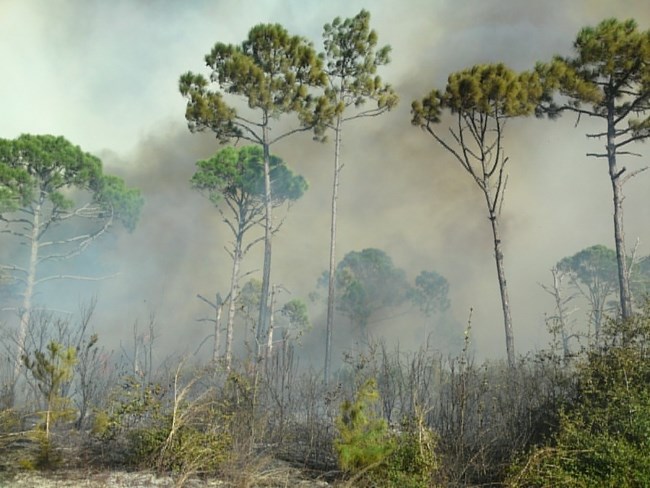
NPS Photo Central Florida is the lightning capital of North America. Hence, the majority of native plant communities at Canaveral National Seashore (CANA) have adapted to periodic fire for their existence. No one can spend much time here without developing a profound respect for lightning and it’s dangers, including wildfire. Sudden thunderstorms are common during summer months. High winds and drought also contribute to the major role of fire in the seashore ecosystem. Intermittent sea breezes and erratic winds associated with thunderstorms alter wind speeds and direction frequently during the day. A small fire can spread quickly when fanned by the wind. Wind speeds above 20 miles per hour are common in winter and spring, with occasional days of 35-40 mph winds. High winds are associated with tropical systems in the summer. In general, fall winds are from the east to northeast, winter winds from the north to northwest, spring winds from the southeast and summer winds from the south. Although Florida is known for an abundance of water and regular summer showers, there is a dry season and occasional periods of drought when fire danger can become extremely high. The dry season typically occurs from November to April. There was an extreme drought in 1981 and then again in 1998. Saw palmetto (Serenoa repens) is the primary fuel that carries fire in the majority of plant communities. Firefighters must combat wildfires differently here than in many other areas. It is too dangerous to build a firebreak directly in front of the fire; rather lines must but built obliquely along the sides or backfires set from an existing line (such as a road) to burn out fuels in the fire's path. This area's fire season is essentially year round. Danger is highest during summer months when temperatures are high and lightning storms are common. While lightning is the primary cause of wildfire in the summer, human actions are the primary culprit during the winter. These include carelessly discarded cigarette butts, unattended campfires, auto exhaust backfires and arson. In the last 50 years, humans have suppressed fire, disrupting the cycle and allowing large amounts of fuel to build up so that when lightning does ignite them the fires are intense. In addition, fire adapted plant communities have been significantly altered, impacting the animal species that rely upon them for habitat. For example, the open stands of oak scrub favored by such state and federally-protected species as the Florida Scrub Jay, Eastern Indigo Snake, Southeastern Beach Mouse and Gopher Tortoise become overgrown and are no longer suitable habitat. Natural fire cycles for CANA's vegetation types are approximately 2-4 years for marshes, 3-5 years for pine flatwoods, 5-10 years for more mesic oak scrub and 8-12 years for drier oak scrub. Hammock areas do not have a regular fire cycle; fire will only carry through them under extremely dry conditions. Vegetation sprouts rapidly after fire in Florida, particularly saw palmetto which has a very thick rhizome (root) system to provide energy for rapid regrowth. A year or so after a fire of normal intensity, the average visitor will not even realize an area has burned. The park is attempting to safely restore a natural fire regime to its plant communities to: 1) maintain natural vegetation communities 2) preserve or restore habitat for several federally-listed animal species and 3) reduce dangerously high fuel loads that could threaten adjacent communities, park buildings and NASA facilities. This will include the use of prescribed fire where it can be safely done. Experts on fire behavior and ecology write very specific prescriptions, stating allowable ranges of temperature, wind-speed, wind direction, relative humidity, fuel moistures, etc that must be met before a prescribed fire is conducted to ensure that all safety concerns and habitat objectives are met. See Animals/Birds for more discussion on the importance of prescribed fire and how it is being utilized to improve habitat for the Florida scrub jay, one of the park's protected species. Using Prescribed Fire to Restore Habitat for Threatened Florida Scrub Jay |
Last updated: December 16, 2024
